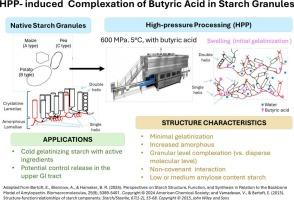丁酸与淀粉颗粒无定形区的配合物经高压处理
IF 9.8
1区 农林科学
Q1 CHEMISTRY, APPLIED
引用次数: 0
摘要
本研究探讨了高压处理(HPP)促进丁酸在玉米、豌豆和马铃薯淀粉颗粒中的捕获的潜力。通过显微镜、固体核磁共振(NMR)和差示扫描量热法(DSC)证实,在600 MPa和5 °C下处理的淀粉表现出部分糊化和非晶态含量增加。丁酸掺入量分别为干重4.1 %(玉米)、5.2 %(豌豆)和4.8 %(马铃薯),p <; 。在x射线衍射分析中未发现有序络合结构。广泛的DSC吸热峰(102-145 °C)表明持续的弱相互作用。这些发现表明,HPP部分破坏了天然淀粉结构,使非共价相互作用在无定形结构域。由此得到的压力改性淀粉可作为短链脂肪酸的递送系统,在冷糊化淀粉和生物活性化合物的控释制剂方面具有潜在的应用前景。本文章由计算机程序翻译,如有差异,请以英文原文为准。


Complex of butyric acid with the amorphous region of starch granules via high-pressure processing
This study investigates the potential of high-pressure processing (HPP) to promote butyric acid entrapment within maize, pea, and potato starch granules. Starch treated at 600 MPa and 5 °C exhibited partial gelatinization and increased amorphous content, as confirmed by microscopy, solid-state nuclear magnetic resonance (NMR), and differential scanning calorimetry (DSC). Butyric acid was incorporated at 4.1 % (maize), 5.2 % (pea), and 4.8 % (potato) by dry weight, p < .05, with no evidence of ordered complexation structures in X-ray diffraction analysis. A broad DSC endothermic peak (102–145 °C) indicated continuous weak interactions. These findings suggest that HPP partially disrupts native starch architecture, enabling non-covalent interactions within amorphous domains. The resulting pressure-modified starches may function as delivery systems for short-chain fatty acids, offering potential applications in cold-gelatinizing starches and controlled-release formulations for bioactive compounds.
求助全文
通过发布文献求助,成功后即可免费获取论文全文。
去求助
来源期刊

Food Chemistry
工程技术-食品科技
CiteScore
16.30
自引率
10.20%
发文量
3130
审稿时长
122 days
期刊介绍:
Food Chemistry publishes original research papers dealing with the advancement of the chemistry and biochemistry of foods or the analytical methods/ approach used. All papers should focus on the novelty of the research carried out.
 求助内容:
求助内容: 应助结果提醒方式:
应助结果提醒方式:


